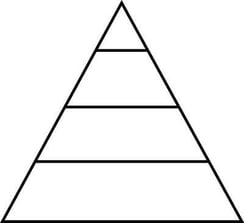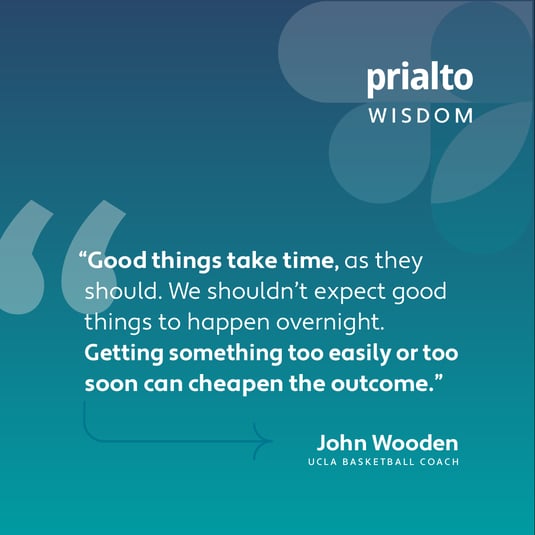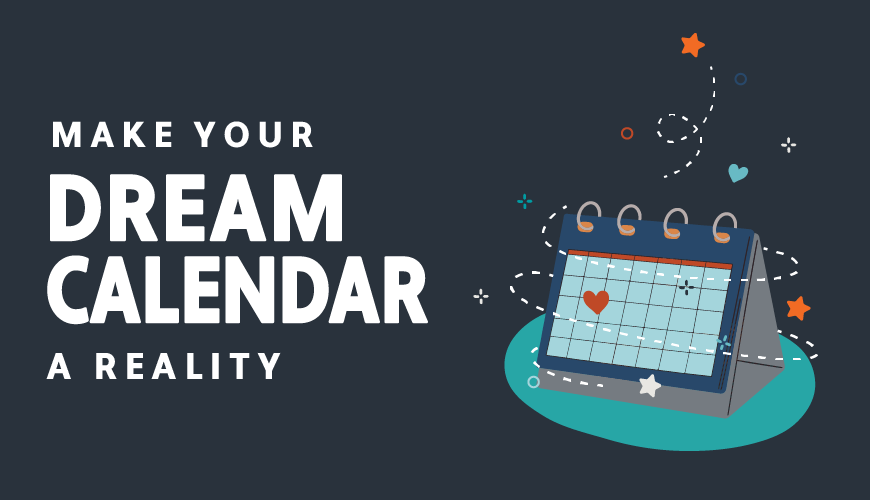Before hiring her Prialto virtual assistant, Mary*, a successful corporate communications entrepreneur and coach, noticed that her work affected her mental wellness.
Her boundaries around work weren’t defined, and she was always rushing to get things done. It was quickly becoming clear that the pace wasn’t sustainable.
This is the reality for many executives who struggle with goal prioritization.
When you don’t prioritize your goals, it’s easy to get overwhelmed by all the details and lose track of what’s really important, — and that can take a toll on both your work and personal life.
What is the most important step in prioritizing goals?
First, get clear on what’s most important to you.
Once you know what’s most important, you have a roadmap to prioritize your goals.
Define priorities through self-inquiry
Entrepreneur and book author Derek Sivers discusses prioritizing goals according to your “hierarchy of values.”
He suggests asking yourself what’s most important with either/or questions and placing your answers on a hierarchy like this:

If you had to choose, would you choose to have more money or time?
Travel or stability?
Would you rather be learning or creating?
Would you rather focus on family or self-cultivation?
Go through all of your goals and compare them to each other to find the ones that stand out. Silvers suggests structuring your entire life around your top priority and letting go of “almost everything else.”
This approach might seem limiting initially because, just like everyone else, you want it all!
But the truth is, while you might be able to achieve many of your goals within your lifetime, you can’t do them all at once.
You can’t write 50 pages of a novel, enjoy a dinner party, direct your kid’s play, and run a marathon on the same day. That’s just not how life works. Some concessions will have to be made so you can focus on what’s most important to you right now.

Decisiveness and honesty are crucial to prioritizing goals.
Only when you’re honest about what you want and need in life can you achieve your goals.
In an interview on The Tim Ferriss Show, James Clear makes this question actionable by asking, “What am I optimizing for [in my life right now]?”
And he continues by pointing out that priorities change over time.
Your priorities today are different from those five years ago, and they will shift again in the future.
You may even have different priorities within the same day. In the morning, your priority may be to focus on a work project, while in the afternoon, your priority could be to exercise, and in the evening, your priority shifts again to spend time with your family. But you have to be clear on what’s important to you before prioritizing your goals.
Another reason to figure out what’s most important to you is to avoid letting other people’s goals dictate your life.
Society, colleagues, family, and friends will all have ideas about how you “should” spend your time. And you’ve probably internalized many of these “shoulds” without even realizing it. But the fact is, other people’s priorities won’t make you happy if they’re not your own.
If you want to differentiate between your values and other people’s opinions, you might consider another question James Clear suggests:
“Does this activity fill me with energy or drain me of energy?”
Activities that align with your values will give you energy, but if you feel drained doing them, you’re likely not being entirely honest with yourself about what you want. You can still do activities that drain your energy if necessary to achieve specific goals, but you might want to put them lower on your priorities list and spend less time on them if you can.
Prioritize the goals that energize you.
How to Create a Plan to Prioritize Your Goals
Once you know your priorities, the next step is to create a plan.
The Getting Things Done Method (GTD)
David Allen’s GTD Method recommends 5 steps to prioritize your goals.
- Capture- Write, record, or gather anything that has your attention.
- Clarify- If it’s actionable, figure out what steps you need to take
- Organize- Categorize content in appropriate places
- Reflect- Review and update content frequently
- Engage- Use this system to make action decisions with confidence and clarity
Mind Mapping
Mind mapping can be particularly beneficial in the process of prioritizing goals, especially for visual learners. It enables you to deconstruct and connect ideas through an intuitive visual format, making it simpler to prioritize goals and clearly identify the next steps to take.
We like MindMeister and Coggle, but there are many mind-mapping tools to choose from.
Do one thing at a time
Once you see all the steps you need to take in one place, you can then use your hierarchy of values to make an implementation plan to reach your goals. But don’t try to do everything at once.
The most effective way to prioritize your goals is to figure out the single, most impactful next step you can take.
In their bestselling book, The One Thing, Gary Keller and James Papasan recommend figuring out the “One Thing” you really want to achieve, and asking yourself what’s one step you can take this day/week/month that will make everything else easier or unnecessary?
All effort doesn’t have the same outcome.
So, if you can only do one thing, what would that one thing be?
The Eisenhower Matrix and Eat the Frog Method can help you figure that out.
When prioritizing goals, how should you order them?
The urgency and importance of each goal can help you determine which to do first.
The Eisenhower Matrix
Steven Covey popularized this method in his best-selling book, The 7 Habits of Highly Effective People.
He suggests you rank each task according to urgency and importance, with urgent tasks being those that need to happen quickly and important tasks being those that will have the biggest impact on your goal.
When a task is identified as both urgent and essential, this is your “One Thing,” and it’s the task to start with.
If another task is urgent but not critical, delegate it. And if a task is necessary but not urgent, do it later. Finally, if something is not urgent nor important, strike it from your list.
Read more about the Eisenhower Matrix here.
Do the most important and urgent thing first
The “One Thing” is derivative of Eat the Frog, a productivity method based on Mark Twain’s quote:
“If it's your job to eat a frog, it's best to do it first thing in the morning. And if it's your job to eat two frogs, it's best to eat the biggest one first.”
You don’t have to be a fan of frog legs to benefit from this. What Twain means is that your actions are aligned with your priorities when you do the most important thing first.
Once you know your “One Thing,” put everything else on hold until that one thing is complete, and then move on to the next urgent and important task.
Conclusion: Create your dream calendar to prioritize your goals
Goal prioritization can help you create your dream calendar, so you can rest easy knowing that you’re taking care of everything that’s important to you.
But as a busy business leader, it can be challenging to find enough time to prioritize your goals in work and life.
Remember Mary, from the beginning of this article?
She was completely overwhelmed by the number of competing tasks she had to keep track of, and it was having an impact on her mental wellbeing. But it wasn’t just that she had too much to do. A big part of her overwhelm came from trying to figure out how to prioritize her goals on her own.
Everything changed once she hired Prialto’s managed virtual assistant service.
Mary told us that her virtual assistant has made her “dream calendar” between work and life a reality, and that she’s experienced a “critical personal shift” in her mental wellness as a result.
Not only that, but Mary’s virtual assistant is helping her stay accountable with an exercise about priorities and work boundaries. With the help of her virtual assistant, Mary can now move through life at a more comfortable pace, without worrying that she’s neglecting anything important.
Want a virtual assistant to create a dream calendar for you, too?
Then set up a free discovery call today and have all of your questions answered about Prialto’s managed virtual assistant service.
*Names have been changed to ensure confidentiality.
